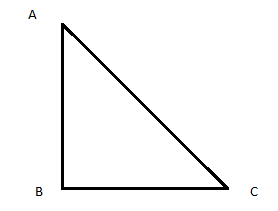
If $\sin \mathrm{A}=\dfrac{3}{4},$ calculate $\cos \mathrm{A}$ and $\tan \mathrm{A}$.
A.$\cos A=\dfrac{\sqrt{3}}{4}$
$\tan A=\dfrac{2}{5}$
B.$\cos A=\dfrac{\sqrt{7}}{4}$
$\tan A=\dfrac{3}{\sqrt{7}}$
C.$\cos A=\dfrac{\sqrt{3}}{2}$
$\tan A=\dfrac{2}{\sqrt{5}}$
D.$\cos A=\dfrac{\sqrt{5}}{7}$
$\tan A=\dfrac{7}{\sqrt{3}}$
Answer
555k+ views
Hint: There are six trigonometric ratios, sine, cosine, tangent, cosecant, secant and cotangent. These six trigonometric ratios are abbreviated as $\sin , \cos ,$ tan, $\mathrm{csc},$ sec, cot. These are referred to as ratios since they can be expressed in terms of the sides of a right-angled triangle for a specific angle $\theta$. Trigonometry is defined as the branch of math that deals with calculations related to the sides and angles of triangles.
Complete step-by-step answer:
The Pythagorean equation relates the sides of a right triangle in a simple way, so that if the
lengths of any two sides are known the length of the third side can be found. Another corollary.

The theorem is that in any right triangle, the hypotenuse is greater than any one of the other sides, but less than their sum.
In a right triangle, the hypotenuse is the longest side, an "opposite" side is the one across from a given angle, and an "adjacent" side is next to a given angle. We use special words to describe the sides of right triangles.
Given, $\sin \mathrm{A}=\dfrac{3}{4}$
$\Rightarrow \dfrac{\mathrm{BC}}{\mathrm{AC}}=\dfrac{3}{4}$
$\Rightarrow \mathrm{BC}=3 \mathrm{k}$ and $\mathrm{AC}=4 \mathrm{k}$
where $\mathrm{k}$ is the constant of proportionality. By Pythagoras theorem, we have $\mathrm{AB}^{2}=\mathrm{AC}^{2}-\mathrm{BC}^{2}=(4 \mathrm{k})^{2}-(3 \mathrm{k})^{2}=7 \mathrm{k}^{2}$
$\Rightarrow \mathrm{AB}=\sqrt{7} \mathrm{k}$
$\mathrm{So}, \cos \mathrm{A}=\dfrac{\mathrm{AB}}{\mathrm{AC}}=\dfrac{\sqrt{7} \mathrm{k}}{4 \mathrm{k}}=\dfrac{\sqrt{7}}{4}$
And $\tan \mathrm{A}=\dfrac{\mathrm{BC}}{\mathrm{AB}}=\dfrac{3 \mathrm{k}}{\sqrt{7} \mathrm{k}}=\dfrac{3}{\sqrt{7}}$
Hence, the correct answer is option B.
Note: The shape of the sine curve is the same for each full rotation of the angle and so the function is called 'periodic'. The period of the function is $360^{\circ}$ or $2 \pi$ radians. We can rotate the point as many times as we like. In mathematical terms we say the 'domain' of the sine function is the set of all real numbers.
The cosine function is a periodic function which is very important in trigonometry. The simplest way to understand the cosine function is to use the unit circle. The $\mathrm{x}$ -coordinate of the point where the other side of the angle intersects the circle is $\cos (\theta),$ and the $y$ -coordinate is $\sin (\theta)$.
Complete step-by-step answer:
The Pythagorean equation relates the sides of a right triangle in a simple way, so that if the
lengths of any two sides are known the length of the third side can be found. Another corollary.

The theorem is that in any right triangle, the hypotenuse is greater than any one of the other sides, but less than their sum.
In a right triangle, the hypotenuse is the longest side, an "opposite" side is the one across from a given angle, and an "adjacent" side is next to a given angle. We use special words to describe the sides of right triangles.
Given, $\sin \mathrm{A}=\dfrac{3}{4}$
$\Rightarrow \dfrac{\mathrm{BC}}{\mathrm{AC}}=\dfrac{3}{4}$
$\Rightarrow \mathrm{BC}=3 \mathrm{k}$ and $\mathrm{AC}=4 \mathrm{k}$
where $\mathrm{k}$ is the constant of proportionality. By Pythagoras theorem, we have $\mathrm{AB}^{2}=\mathrm{AC}^{2}-\mathrm{BC}^{2}=(4 \mathrm{k})^{2}-(3 \mathrm{k})^{2}=7 \mathrm{k}^{2}$
$\Rightarrow \mathrm{AB}=\sqrt{7} \mathrm{k}$
$\mathrm{So}, \cos \mathrm{A}=\dfrac{\mathrm{AB}}{\mathrm{AC}}=\dfrac{\sqrt{7} \mathrm{k}}{4 \mathrm{k}}=\dfrac{\sqrt{7}}{4}$
And $\tan \mathrm{A}=\dfrac{\mathrm{BC}}{\mathrm{AB}}=\dfrac{3 \mathrm{k}}{\sqrt{7} \mathrm{k}}=\dfrac{3}{\sqrt{7}}$
Hence, the correct answer is option B.
Note: The shape of the sine curve is the same for each full rotation of the angle and so the function is called 'periodic'. The period of the function is $360^{\circ}$ or $2 \pi$ radians. We can rotate the point as many times as we like. In mathematical terms we say the 'domain' of the sine function is the set of all real numbers.
The cosine function is a periodic function which is very important in trigonometry. The simplest way to understand the cosine function is to use the unit circle. The $\mathrm{x}$ -coordinate of the point where the other side of the angle intersects the circle is $\cos (\theta),$ and the $y$ -coordinate is $\sin (\theta)$.
Recently Updated Pages
Master Class 11 Chemistry: Engaging Questions & Answers for Success

Which is the Longest Railway Platform in the world?

India Manned Space Mission Launch Target Month and Year 2025 Update

Which of the following pairs is correct?

The Turko-Afghan rule in India lasted for about?

Who wrote the novel "Pride and Prejudice"?

Trending doubts
What is meant by exothermic and endothermic reactions class 11 chemistry CBSE

Which type of resource is iron ore A Renewable B Biotic class 11 social science CBSE

10 examples of friction in our daily life

Differentiate between an exothermic and an endothermic class 11 chemistry CBSE

Difference Between Prokaryotic Cells and Eukaryotic Cells

1 Quintal is equal to a 110 kg b 10 kg c 100kg d 1000 class 11 physics CBSE




